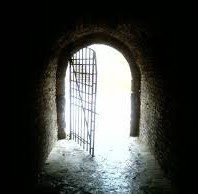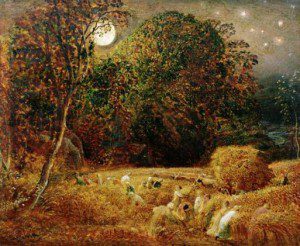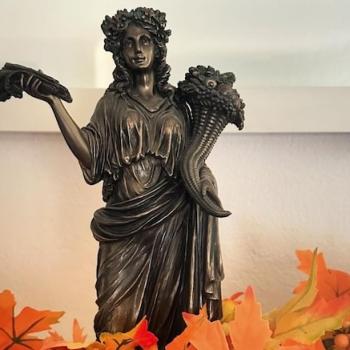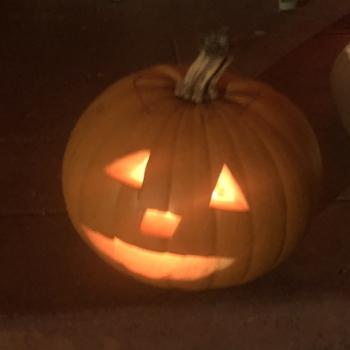 As we celebrate the second harvest of Mabon and feel the air turn crisp around us, we begin to realize that summer is truly fading away and the dark of the year is upon us. For some, this is a time of excitement as we dance with the true nature of darkness at Samhain and prepare for the joy of holiday gift giving weeks later. Those who enjoy winter sports and other cold weather activities get amped up to change gears into a different type of activity rush.
As we celebrate the second harvest of Mabon and feel the air turn crisp around us, we begin to realize that summer is truly fading away and the dark of the year is upon us. For some, this is a time of excitement as we dance with the true nature of darkness at Samhain and prepare for the joy of holiday gift giving weeks later. Those who enjoy winter sports and other cold weather activities get amped up to change gears into a different type of activity rush.
For many, however, the dark of the year is a challenge, not only for Pagan people, but also for society in general. Distress during this time is so prevalent that we have legitimized actual diseases and conditions, such as Seasonal Affective Disorder, which is an outcropping from the lack of light that occurs in the winter months. Suicide rates go up, particularly around the holidays. Stress from expectations, direct and implied, coupled with confrontations with unrealized goals can take us under more so in the darkness than in the light. Even the optimism of New Year resolutions is typically short lived, which brings on its own contribution to the cycle of dismay that can permeate a time of year that, objectively speaking, is no more sinister than is its sunshine-filled counterpart.
 As magical people, we often rightly resist the tendency of others to demonize the dark and equate darkness with evil. Even children often have an innate fear of the dark. Throughout many mainstream religions, we hear references to “good” as “light” and “bad” as “dark.” We sigh and explain the truth about “black” magic and “white” witchcraft. We hear sweet newbies surround themselves with white light to protect themselves and drive away any darkness, which is effective, but more so if darkness is used in tandem for its ability to actually absorb and neutralize negative energy rather than just ward it off. We fearlessly brandish the yin and yang symbol and say wise things about the need for both, about the equality, and about the tiny spot of each that lies in the heart of the other. We tell our students that in order to walk in the light, they must understand the darkness, not only in the world and in magic, but also in ourselves.
As magical people, we often rightly resist the tendency of others to demonize the dark and equate darkness with evil. Even children often have an innate fear of the dark. Throughout many mainstream religions, we hear references to “good” as “light” and “bad” as “dark.” We sigh and explain the truth about “black” magic and “white” witchcraft. We hear sweet newbies surround themselves with white light to protect themselves and drive away any darkness, which is effective, but more so if darkness is used in tandem for its ability to actually absorb and neutralize negative energy rather than just ward it off. We fearlessly brandish the yin and yang symbol and say wise things about the need for both, about the equality, and about the tiny spot of each that lies in the heart of the other. We tell our students that in order to walk in the light, they must understand the darkness, not only in the world and in magic, but also in ourselves.
With darkness maligned so, even by our own practices at times, is it any wonder why the dark of the year can be a scary place to go? For the thousands of years that most societies were agriculturally based people, villages structured life around the seasons of the year and the moon cycles. These two celestial forces dictated when to plant, when to harvest, when to cull the herds, and just as importantly, when to put the year to rest. It is unlikely that the psychological struggles that many people now face in the dark of the year were present when we tuned in so intently to the natural cycles.
At Samhain, our ancestors honored not only the deaths of those that went before them, but also the death of the harvest. Crops left in the field on November 1st were thought to be poisoned; touched by the Trickster and unfit to eat. We know, and likely, our ancestors did as well, that the crops left on the stem on November 1st are no different than those that were there on October 30th. What they did understand, however, is the human need for cycles. Just as we need the light, we need the darkness. Just as we need the activity of the harvest year, we need the quiet and introspection of the dark of the year. Samhain gave them a well-defined line to respect the transition into the dark. It also encouraged them to “make hay while the sun is shining” and get the hard work of harvest completed before this deadline.
Samhain told them and, if we allow its influence fully into our lives, it tells us, when to say “when.” It gives us delineation between the light of the year and the dark. It tells us to stop wanting from The Universe and to let go of expectations and more importantly, to change our definition of success and productivity for a few months. During the active time of the harvest, we work hard. This applies to actual farmers, then and now, as well as those who do not literally farm, but who “grow” goals in their lives and in their year. During the time of light, there are more hours of sunlight and the weather is more hospitable, so we naturally increase our productive hours and engage in longer periods of active work. As the days grow shorter, we can feel our bodies craving rest and quiet. Even nature tells us to go inside as temperatures drop and there is less light on our share of the earth.
 To this end, Samhain tells us to change gears and adapt our lives into the dark of the year. It teaches us acceptance of “what is” and encourages us to mourn our losses and acknowledge that what we have and who we are right now, in this moment, is enough. Samhain tells us to let go of wanting and lusting after particular outcomes and to let our fields rest for a time while we adjust and find our own center again.
To this end, Samhain tells us to change gears and adapt our lives into the dark of the year. It teaches us acceptance of “what is” and encourages us to mourn our losses and acknowledge that what we have and who we are right now, in this moment, is enough. Samhain tells us to let go of wanting and lusting after particular outcomes and to let our fields rest for a time while we adjust and find our own center again.
Unfortunately, most of us do not have lives that easily accommodate a reduction in productivity during the dark of the year. We usually work jobs that demand the same output during the winter that occurs during the summer. We create artificial lighting to extend our workdays into the night. We drink energy drinks to stay awake longer and coffee to wake us up earlier. In many first world societies, nothing less than “go, go, go” and “produce, produce, produce” is considered acceptable behavior for adults. My position is that it is time for us to reclaim the dark and the gifts it brings to us.
Even with the demands of modern life upon us, we can make subtle changes to welcome the darkness and create an alliance, using it to our own fullest advantage. As anyone who has ever done a full walkabout in their own head can tell you, there is always value in the darkness and it is, in fact, where the best lessons live. As magical people, it is not only clever of us to dive into the dark of the year and work its natural progression, but it is very nearly mandatory. As we progress in wisdom and energy development, we naturally gravitate or are led to a full exploration of light and dark in all of their glory and aspects. The seasons are simply one natural representation, providing a bracketed and distinct arena in which to stretch our boundaries and learn more about these concepts.
With its emphasis on planning and quiet introspection, the dark of the year is the perfect time to go inward and take inventory of where we are in life and where we want to be. Just as the farmers used this time to plan the coming year’s crops, we can give serious evaluation to what needs to change in our lives and how we can be better people and stronger representations of God and Goddess on earth. We can get to know ourselves better, stripping away the masks and labels we wear for society and bringing our authentic selves into focus. No matter how hard we try to remain plugged in and in touch with who we truly are, the demands and frustrations of the outside world will inevitably distract us from time to time. Dark of the year is an ideal time to reseat ourselves in who we truly are and what we stand for in this world.
 How would you change your life to honor and welcome the dark of the year? Most Pagans have two preferred methods of transitioning energy: rituals and burning stuff, preferably in conjunction with one another. Our Higher Selves respond very favorably to ritual, which is a perfect common ground for communication between the Higher Self and the Conscious Self. Ritualizing the transition between the light and dark of the year allows your Mind, Body, and Spirit to acknowledge the natural shift and ease into the flow of the change. Ignoring the shift, however, and acting as though the entire year has the same flavor and objective can throw our entire energy processes out of whack.
How would you change your life to honor and welcome the dark of the year? Most Pagans have two preferred methods of transitioning energy: rituals and burning stuff, preferably in conjunction with one another. Our Higher Selves respond very favorably to ritual, which is a perfect common ground for communication between the Higher Self and the Conscious Self. Ritualizing the transition between the light and dark of the year allows your Mind, Body, and Spirit to acknowledge the natural shift and ease into the flow of the change. Ignoring the shift, however, and acting as though the entire year has the same flavor and objective can throw our entire energy processes out of whack.
In practical terms, in order to get the most out of the dark of the year, we have to consider what our ancestors did because that is the message programmed deeply into our DNA and collective conscience. When the last grains were harvested and the torch was put to the fields for the year, the primary work of harvest stopped. Throughout the harvest process, the food was “put back” into storage through many processes, such as canning and storing in silos. When that was completed, the work of harvest finalized and life changed considerably. By no means did the farm go to sleep for the year. There were still animals to tend, meals to prepare, and repairs to make, but the energy shifted to a different kind of productivity. Men hunted for meat to supplement the harvest. Women no longer worked in the fields with their families, so weaving and creating took focus. Because of the reduction in light, people slept more, rising later and going to bed earlier. The cold weather brought families around the fire to visit and share stories, often sleeping together for warmth. This entire process created a stronger sense of togetherness and renewed family bonds. It was a time for sharing and for learning from one another.
Adapting into the natural flow of if this valuable time of year is easier than most people imagine. The automatic instinct is to insist that everything you do is entirely vital and that you could not possibly make time to slow down. Often, this is our ego talking rather than reality. There are always places to create wiggle room to let the quiet in and release unnecessary activities.
The first time I worked on this adjustment, I was a single mother of four children working three jobs, one of which was full time. I was well within anyone’s definition of overtaxed, overworked, overstressed, and overextended. I had to find even tiny moments where I could be still. I would even sit in the bathroom and breathe, letting my mind slow down while I visualized myself walking into the darkness. As I finally went to bed at night, I would lead myself in meditation, opening my spirit to the lessons of the darkness and taking time to breathe in, breathe out, and feel quietness move through me. Even the smallest increments of stillness can work collectively to effectively transition you into the darkness.
Let Samhain tell you that it is time to:
– Read books
– Spend time with family and friends
– Explore your creative interests
– Consciously slow your mind into restfulness. This can often be a process since we are not usually used to doing so.
– Drink warm beverages that are non-stimulating.
– Make time to rest and recover from stresses of the year.
– Say “no” to activities and invitations that do not promote restfulness and peace. Streamline your calendar and eliminate non-essential activities.
– Listen to and rediscover your favorite music.
– Clean and clear your living area and decorate according to the energy of the season to provide visual cues for the energy transition.
– Surround yourself with sensual reminders of the time, such and oils and incenses, altar areas, affirmation prompts, changes in musical choices, and special foods of the season.
When you celebrate Samhain this year, in addition to your other points of focus, take the time to welcome the darkness and the lessons it brings to you. Thank the light of the year and all that it gave to you. Ask the Wise Ones of your choosing to guide you through the lessons of the Dark and open your mind to the wisdom therein. Write what you want to release into the past onto paper, ribbons, or cornhusks and burn that stuff away to move naked and unencumbered into the dark of the year. Give your Higher Self the message that it is safe to follow the natural flow and that you will honor the need to go into the dark and find what is there for you.
 Allow yourself to lie fallow during the six weeks between Samhain and Winter Solstice. Make an earnest attempt to reject all unnecessary activities, even going so far as to inform close friends and family that you are taking some much needed time off. Do as little as possible and resist the urge to plan, to worry, or to think ahead. Sure, you still have obligations and you must honor those, but take a serious inventory of your time and energy investment and see how much you can pare back. Put yourself on skeleton crew and refuse to do one thing more than you absolutely have to do.
Allow yourself to lie fallow during the six weeks between Samhain and Winter Solstice. Make an earnest attempt to reject all unnecessary activities, even going so far as to inform close friends and family that you are taking some much needed time off. Do as little as possible and resist the urge to plan, to worry, or to think ahead. Sure, you still have obligations and you must honor those, but take a serious inventory of your time and energy investment and see how much you can pare back. Put yourself on skeleton crew and refuse to do one thing more than you absolutely have to do.
When Winter Solstice comes, let that spark of light that returns to the sky ignite your goals and aspirations for the year. Reflect on the harvest year before and what you manifested into your life and imagine how you want your life to look on November 1st of the coming year. Do not allow yourself concern about how those changes will happen. Just dream and write it all down. Make a list to keep and a list to burn and offer the list up to the God and Goddess as your will for the year. There is no need to plan the trip just yet. Right now, you are creating the destination.
Look for meditative minutes in your day and use them to explore the dark corners in yourself and engage dialogue with your own demons. Gently explore what obstacles you create to your own success and how you can improve relationships and other personal processes. Find the lies you tell yourself and objectify them until you find the truth. Take this time to revisit old experiences that you perceive as failures and give them new labels as essential lessons in your life. Observe in retrospect the work of the Gods in your life and see how wisdom and skill (even treachery!) were created from adversity. Honor your strengths and forgive your weaknesses, knowing that the use of both or either is entirely within your control in the coming year.
The winter can be a very safe and enjoyable place when used correctly. Find your “winter pace” and wear it until Spring Equinox when the active part of the year begins again. Your chi will thank you.
__________________
I’m Jason, I usually write most of the stuff here at Raise the Horns but I’m on vacation pilgrimage in the British Isles and won’t have a lot of time for writing so I got some of my friends to help me out! Thanks Katrina for this great article! Beyond my wildest expectations for a guest shot here at RtH. Check out more great stuff from Katrina in the links below!
__________________
Katrina Rasbold has provided insightful guidance to countless individuals over the past three decades through both her life path consultations and her informative classes and workshops. She has worked with teachers all over the world, including three years of training in England and two years of practice in the Marianas Islands. A prolific author, she has written many books on the subjects of magical practice, energy manipulation, and positive life manifestation.
She is a professional life coach who holds a Ph.D. in Religion with a minor in Psychology. She and her husband, Eric Rasbold, are the founders of CUSP (Climbing Up the Spiral Pathway), a program designed to manifest positive, long term life changes by following the ancient agricultural cycles throughout the year. CUSP has touched the lives of literally thousands of people since its inception in 1997 and is practiced as a life pattern and spiritual path all over the United States and in other countries as well. Their book “The CUSP Way” explains the details of this vibrant and productive process of personal manifestation and works with other books from the Bio-Universal/Energy Magic series to instruct users on the use of their own empowerment and that of The Divine to improve their life.
Katrina has been an avid practitioner of the magical arts since the early 1980s and the study of all ways that humans enjoy congress with God is her passion. She currently teaches classes in the Sacramento and El Dorado County areas of California. She and Eric run a thriving circle and are on the board of directors of North Western Circle Association.

















